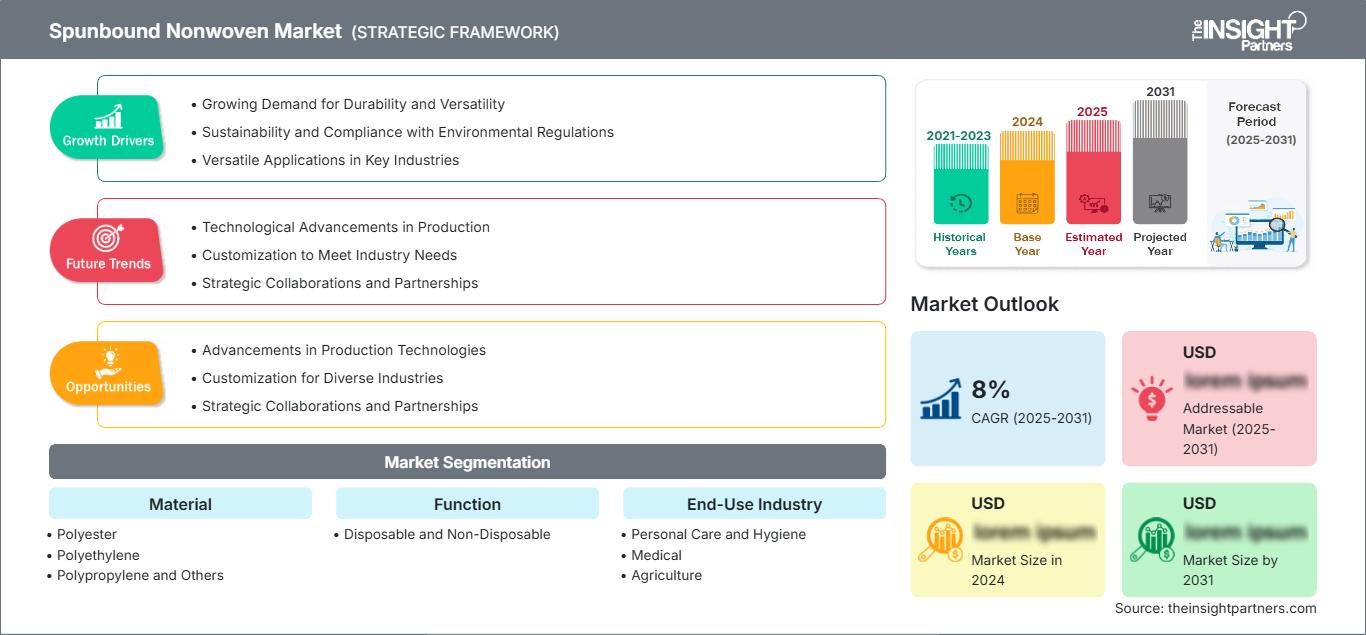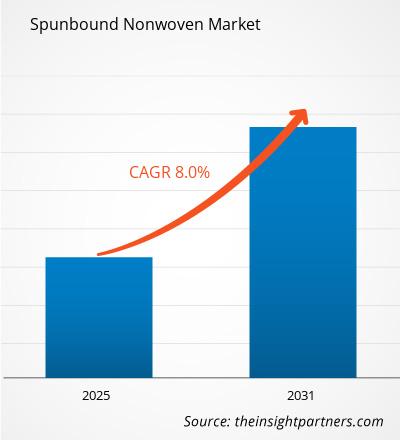Si prevede che il mercato del tessuto non tessuto spunbound registrerà un CAGR dell'8% dal 2025 al 2031, con una dimensione del mercato in espansione da XX milioni di dollari nel 2024 a XX milioni di dollari entro il 2031.
Il rapporto è segmentato per materiale (poliestere, polietilene, polipropilene e altri) e funzione (usa e getta e non usa e getta). Il rapporto presenta inoltre un'analisi basata sul settore di utilizzo finale (cura e igiene personale, medicina, agricoltura, imballaggio, automotive e altri). L'analisi globale è ulteriormente suddivisa a livello regionale e per i principali paesi. Le dimensioni e le previsioni del mercato a livello globale, regionale e nazionale per tutti i principali segmenti di mercato sono trattate nell'ambito di applicazione. Il rapporto fornisce il valore in USD per l'analisi e i segmenti sopra indicati. Il rapporto fornisce statistiche chiave sullo stato del mercato dei principali attori del mercato e offre tendenze e opportunità di mercato.
Scopo del rapporto
Il rapporto "Spunbound Nonwoven Market" di The Insight Partners mira a descrivere il panorama attuale e la crescita futura, i principali fattori trainanti, le sfide e le opportunità. Ciò fornirà spunti a vari stakeholder aziendali, come:
- Fornitori/Produttori di tecnologia: per comprendere le dinamiche di mercato in evoluzione e conoscere le potenziali opportunità di crescita, consentendo loro di prendere decisioni strategiche informate.
- Investitori: per condurre un'analisi completa delle tendenze in merito al tasso di crescita del mercato, alle proiezioni finanziarie di mercato e alle opportunità esistenti lungo la catena del valore.
- Enti di regolamentazione: per regolamentare le politiche e le attività di controllo sul mercato con l'obiettivo di ridurre al minimo gli abusi, preservare la fiducia degli investitori e sostenere l'integrità e la stabilità del mercato.
Materiale di segmentazione del mercato dei tessuti non tessuti filati
- Poliestere
- Polietilene
- Polipropilene e altri
Funzione
- Monouso e non monouso
Settore di utilizzo finale
- Cura della persona e igiene
- Medico
- Agricoltura
- Imballaggio
- Automotive e altri
Geografia
- Nord America
- Europa
- Asia-Pacifico
- America meridionale e centrale
- Medio Oriente e Africa
Potrai personalizzare gratuitamente qualsiasi rapporto, comprese parti di questo rapporto, o analisi a livello di paese, pacchetto dati Excel, oltre a usufruire di grandi offerte e sconti per start-up e università
Mercato dei tessuti non tessuti filati: Approfondimenti strategici

- Ottieni le principali tendenze chiave del mercato di questo rapporto.Questo campione GRATUITO includerà l'analisi dei dati, che vanno dalle tendenze di mercato alle stime e alle previsioni.
Fattori della crescita del mercato dei tessuti non tessuti spunbond
- Crescente domanda di durata e versatilità: i tessuti non tessuti spunbond rappresentano l'ultima tendenza nel mercato dei tessuti. I tessuti non tessuti spunbond sono disponibili in termini di durata, versatilità e varietà di applicazioni. Sono comunemente utilizzati in settori come l'automobile, l'edilizia, la filtrazione e la cura della persona. Con la crescente domanda di soluzioni ad alte prestazioni e convenienti, l'interesse crescente per i tessuti non tessuti spunbond è comprensibile.
- Sostenibilità e conformità alle normative ambientali: la crescente domanda di tessuti non tessuti spunbond è dovuta principalmente al cambiamento generale del panorama verso la sostenibilità e la conformità a normative ambientali più severe. In genere, i cosiddetti materiali "ambientalisti" sono i più apprezzati per i tessuti non tessuti spunbond, poiché la maggior parte di essi può essere riciclata o riutilizzata. Il consumo di prodotti sostenibili sta diventando sempre più dominante e talvolta richiesto da governi e consumatori, aumentando così in modo significativo la domanda nella categoria dei tessuti non tessuti spunbond.
- Applicazioni versatili in settori chiave: un altro fattore che stimola la domanda di tessuto non tessuto spunbond è la presenza di applicazioni di successo nei settori dell'edilizia, dell'automotive e della cura della persona. La domanda di materiali versatili, leggeri e durevoli come i tessuti non tessuti spunbond aumenta sempre di più con l'aumento delle dimensioni di questi settori. La crescita demografica in tutto il mondo favorisce lo sviluppo di infrastrutture e beni di consumo, aumentando la domanda per questo mercato.
Tendenze future del mercato dei tessuti non tessuti spunbond
- Progressi tecnologici nella produzione: i produttori di tessuti non tessuti spunbond hanno continuato a impegnarsi nel corso degli anni per migliorare lo sviluppo delle tecnologie di produzione, il che aumenterebbe l'efficienza, la qualità e ridurrebbe il prezzo dei tessuti non tessuti spunbond. Le linee di produzione ad alta velocità sono abbinate a tecniche di saldatura delle fibre condivise, ulteriormente potenziate da efficaci opzioni di automazione e robotica per migliorare l'intero processo produttivo. Tutti questi progressi tecnologici possono contribuire a rendere la produzione più adeguata e a soddisfare la crescente domanda di tessuti non tessuti spunbond.
- Personalizzazione per soddisfare le esigenze del settore: la crescente tendenza alla personalizzazione dei prodotti in tessuto non tessuto spunbond è quella di soddisfare le diverse esigenze di ciascun settore di utilizzo finale. I produttori offrono numerose opzioni in termini di composizione delle fibre, peso del tessuto o finiture superficiali. Un'organizzazione può distinguere il proprio prodotto dagli altri attraverso prodotti personalizzati e ottenere un vantaggio competitivo sul mercato.
- Collaborazioni e partnership strategiche: il mercato dei tessuti non tessuti spunbond assiste sempre più all'emergere di collaborazioni e partnership strategiche tra produttori, fornitori di materie prime e settori di utilizzo finale. Queste partnership sono specificamente mirate a migliorare lo sviluppo del prodotto, a migliorare l'efficienza della catena di fornitura e a consentire un'ulteriore espansione sul mercato. Le organizzazioni stanno sempre più unendo le forze per accedere a competenze e risorse complementari e innovare al meglio per soddisfare le mutevoli esigenze del mercato.
Opportunità di mercato per i tessuti non tessuti spunbound
- Progressi nelle tecnologie di produzione: lo sviluppo di tecnologie di produzione avanzate è diventato un impegno costante per i produttori per migliorare la qualità, l'efficienza e la convenienza nella produzione di tessuti non tessuti spunbound. Linee di produzione ad alta velocità, miglioramenti nella legatura delle fibre e l'integrazione di automazione e robotica hanno portato a un miglioramento complessivo della produzione. Questi progressi consentono ai produttori di soddisfare la domanda sempre più elevata di tessuti non tessuti spunbond.
- Personalizzazione per diversi settori: una tendenza crescente nella produzione di tessuti non tessuti spunbound riguarda la loro adattabilità ai diversi settori di utilizzo finale. I produttori offrono ai propri clienti una gamma sempre più ampia di opzioni in termini di composizione delle fibre, peso dei tessuti e finiture superficiali. La differenziazione e il vantaggio competitivo offerti alle aziende attraverso la personalizzazione dei prodotti sarebbero eccezionali.
- Collaborazioni e partnership strategiche: il mercato dello spunbond non tessuto continua a crescere grazie alla collaborazione e alla partnership strategica tra produttori, fornitori di materie prime e utilizzatori finali. Ciò riunirà questi partner in un mercato condiviso, in linea con la riduzione dei costi e il miglioramento dello sviluppo dei prodotti, nonché con il miglioramento dell'efficienza nella catena di fornitura e l'ampliamento degli orizzonti di mercato. Questi stakeholder promuovono inoltre l'innovazione per un servizio migliore alle esigenze in continua evoluzione del mercato.
Approfondimenti regionali sul mercato dei tessuti non tessuti spunbound
Le tendenze regionali e i fattori che influenzano il mercato del tessuto non tessuto spunbound durante il periodo di previsione sono stati ampiamente spiegati dagli analisti di The Insight Partners. Questa sezione illustra anche i segmenti e la geografia del mercato del tessuto non tessuto spunbound in Nord America, Europa, Asia-Pacifico, Medio Oriente e Africa, America meridionale e centrale.
Ambito del rapporto di mercato sui tessuti non tessuti spunbound
| Attributo del rapporto | Dettagli |
|---|---|
| Dimensioni del mercato in 2024 | US$ XX million |
| Dimensioni del mercato per 2031 | US$ XX Million |
| CAGR globale (2025 - 2031) | 8% |
| Dati storici | 2021-2023 |
| Periodo di previsione | 2025-2031 |
| Segmenti coperti |
By Materiale
|
| Regioni e paesi coperti | Nord America
|
| Leader di mercato e profili aziendali chiave |
|
Densità degli attori del mercato dei tessuti non tessuti spunbound: comprendere il suo impatto sulle dinamiche aziendali
Il mercato del tessuto non tessuto spunbound è in rapida crescita, trainato dalla crescente domanda degli utenti finali, dovuta a fattori quali l'evoluzione delle preferenze dei consumatori, i progressi tecnologici e una maggiore consapevolezza dei vantaggi del prodotto. Con l'aumento della domanda, le aziende stanno ampliando la propria offerta, innovando per soddisfare le esigenze dei consumatori e sfruttando le tendenze emergenti, alimentando ulteriormente la crescita del mercato.

- Ottieni il Mercato dei tessuti non tessuti filati Panoramica dei principali attori chiave
Punti di forza
- Copertura completa: il rapporto copre in modo completo l'analisi di prodotti, servizi, tipologie e utenti finali del mercato del tessuto non tessuto spunbound, fornendo un panorama olistico.
- Analisi degli esperti: il rapporto è compilato sulla base della conoscenza approfondita di esperti e analisti del settore.
- Informazioni aggiornate: il rapporto garantisce rilevanza aziendale grazie alla sua copertura di informazioni recenti e tendenze dei dati.
- Opzioni di personalizzazione: questo rapporto può essere personalizzato per soddisfare le esigenze specifiche del cliente e adattarsi in modo appropriato alle strategie aziendali.
Il rapporto di ricerca sul mercato del tessuto non tessuto spunbound può, quindi, aiutare a guidare il percorso di decodificazione e comprensione dello scenario del settore e delle prospettive di crescita. Sebbene possano esserci alcune preoccupazioni valide, i vantaggi complessivi di questo rapporto tendono a superare gli svantaggi.
- Analisi storica (2 anni), anno base, previsione (7 anni) con CAGR
- Analisi PEST e SWOT
- Valore/volume delle dimensioni del mercato - Globale, Regionale, Nazionale
- Industria e panorama competitivo
- Set di dati Excel
Report recenti
Testimonianze
Motivo dell'acquisto
- Processo decisionale informato
- Comprensione delle dinamiche di mercato
- Analisi competitiva
- Analisi dei clienti
- Previsioni di mercato
- Mitigazione del rischio
- Pianificazione strategica
- Giustificazione degli investimenti
- Identificazione dei mercati emergenti
- Miglioramento delle strategie di marketing
- Aumento dell'efficienza operativa
- Allineamento alle tendenze normative




















 Ottieni un campione gratuito per - Mercato dei tessuti non tessuti filati
Ottieni un campione gratuito per - Mercato dei tessuti non tessuti filati